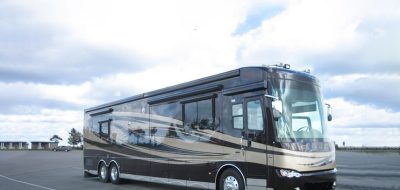
With the exception of pilot type water heaters and some smaller LP/Electric refrigerators, modern LP appliances in RVs are controlled by electronics, meaning the gas valve is opened, the flame is ignited, and the flame is “proved” (flame safety- making certain the burner is burning). These systems are used for a number of reasons:
- No “standing” pilot flame to waste energy.
- Set and forget operation- for refrigerators, automatic energy selection (LP or 120 volt).
- Operation more like the home appliances
There are 2 methods of “proving” the flame. A purely electronic method, and what I call a “hybrid” method- both are in common use today, and both have specific troubleshooting steps to diagnose any failures.
What I call “hybrid” systems are those that will use an electronic ignitor to light the flame, but will use a thermocouple to detect the flame. This system is most commonly used in newer model Dometic refrigerators.
 In the schematic shown (of a Dometic refrigerator), the thermocouple is hooked directly to the circuit board (circuit outlined in yellow), and the igniter circuit is outlined in red. The circuit board sends power to the gas valve and igniter for a set time, when the flame ignites, the thermocouple sends a small voltage (around 25-30 millivolts) to the circuit board, letting it know the flame is burning. In this system, the checks to be made are for a good flame, the end of the thermocouple needs to be in the flame, and the voltage from the thermocouple needs to be tested.
In the schematic shown (of a Dometic refrigerator), the thermocouple is hooked directly to the circuit board (circuit outlined in yellow), and the igniter circuit is outlined in red. The circuit board sends power to the gas valve and igniter for a set time, when the flame ignites, the thermocouple sends a small voltage (around 25-30 millivolts) to the circuit board, letting it know the flame is burning. In this system, the checks to be made are for a good flame, the end of the thermocouple needs to be in the flame, and the voltage from the thermocouple needs to be tested.
Early Dometic models had grounding issues- the gas valve got its ground through the circuit board, but the thermocouple was hooked to the ground strip. When the ground connections got a bit of corrosion, the ground reference point the circuit board saw would “float” above zero, and the board would not see the small millivolt signal from the thermocouple. Almost all of these have had wiring harnesses retrofitted to take care of this problem.
In fully electronic ignition systems, no thermocouple is used. This type of system is used in furnaces, water heaters and Norcold refrigerators . Because this type has no thermocouple, some other method of detecting whether the flame is burning is needed. Enter the principals of flame rectification and flame ionization- which basically use the fact that a flame can conduct electrical current to electronically sense whether a flame is burning. (for a bit of somewhat “dry” reading, you can look at some patents- a 1944 Flame detection patent, a 1971 patent, and a 1979 digital flame detection patent (looking up patents from patent numbers can be interesting for equipment geeks like me!). The current which is conducted through the flame is between 8 and 15 microamps.
O.K., but what does this all mean? In its basic form, this type of DSI (Direct Spark Ignition, a.k.a electronic ignition) system has a few basic requirements. The ignition control module (board) needs the proper supply voltage, the flame needs to be the proper size, the electrode (which is just a wire- nothing more) has to be in the flame, and in order for the flame detection to work properly, the return path for the small current needs to be good- which is basically the ground path and connections.
 In this picture of an Atwood DSI water heater, you can see the main circuit board connection and the single wire to the spark gap. Note that older DSI appliances used a separate wire and a separate flame sense electrode, whereas new models use the spark gap itself for flame detection. If you think about it for a minute, and keep in mind the principals that Larry Cad talked about in his blog post, What is a Circuit?, you will realize that in order for the very small flame current to make it back to the circuit board, it has to go through the burner mounting screw, the sheet metal around the burner and then through the ground connection on the main connector of the circuit board- all of this after making it through the flame itself. The trouble with this is that there are several places where the small current can get cut down to below the point where the board thinks the flame is burning.
In this picture of an Atwood DSI water heater, you can see the main circuit board connection and the single wire to the spark gap. Note that older DSI appliances used a separate wire and a separate flame sense electrode, whereas new models use the spark gap itself for flame detection. If you think about it for a minute, and keep in mind the principals that Larry Cad talked about in his blog post, What is a Circuit?, you will realize that in order for the very small flame current to make it back to the circuit board, it has to go through the burner mounting screw, the sheet metal around the burner and then through the ground connection on the main connector of the circuit board- all of this after making it through the flame itself. The trouble with this is that there are several places where the small current can get cut down to below the point where the board thinks the flame is burning.
Places to look are the spark gap itself- should be 3/16″, and fully in the flame, the connection of the burner tube (in the newest models this area has been improved by a new mounting procedure), and the connector itself- probably the most common point of failure, and the easiest to remedy- simply remove the edge connector and gently clean the printed circuit conductors- the usual recommendation is to use a pencil eraser, but you must do it gently, so as to not remove the plating from the board.
 Other control components in the Atwood DSI water heater are the thermostat, which is just an on/off temperature controlled switch, the flame fuse, which is meant to open if the flame burns outside the burner tube, and the E.C.O., which is an over temperature switch which will open up if the water gets too hot. Both the thermostat and the flame fuse are in the power supply to the circuit board, and the E.C.O. is in the output of the circuit board going to the gas valve.
Other control components in the Atwood DSI water heater are the thermostat, which is just an on/off temperature controlled switch, the flame fuse, which is meant to open if the flame burns outside the burner tube, and the E.C.O., which is an over temperature switch which will open up if the water gets too hot. Both the thermostat and the flame fuse are in the power supply to the circuit board, and the E.C.O. is in the output of the circuit board going to the gas valve.
Next week I’ll talk about the use of DSI circuits in the RV furnace, and the safety systems they use.
Questions or comments, see this thread in the RV.Net forums.






Pingback: viagra online
microwave oven
Jon vermilye.
Your post is tremendous.I am a student of mechanical engineering working with ignition system and it implementation at real time.This post helped me to get better idea.
Thanks ..keep doing.
Pingback: LP Appliances- Furnaces
Jon Vermilye
Another “interesting but geekie” result of flame ionization is the ability to build a loudspeaker from a flame. If interested, check May 1968 Popular Electronics Article on Flame Loudspeakers. It does work – one of my students just had to build one!